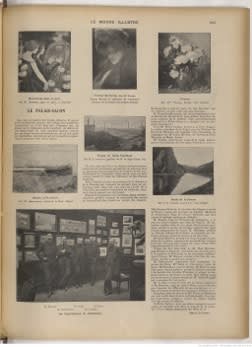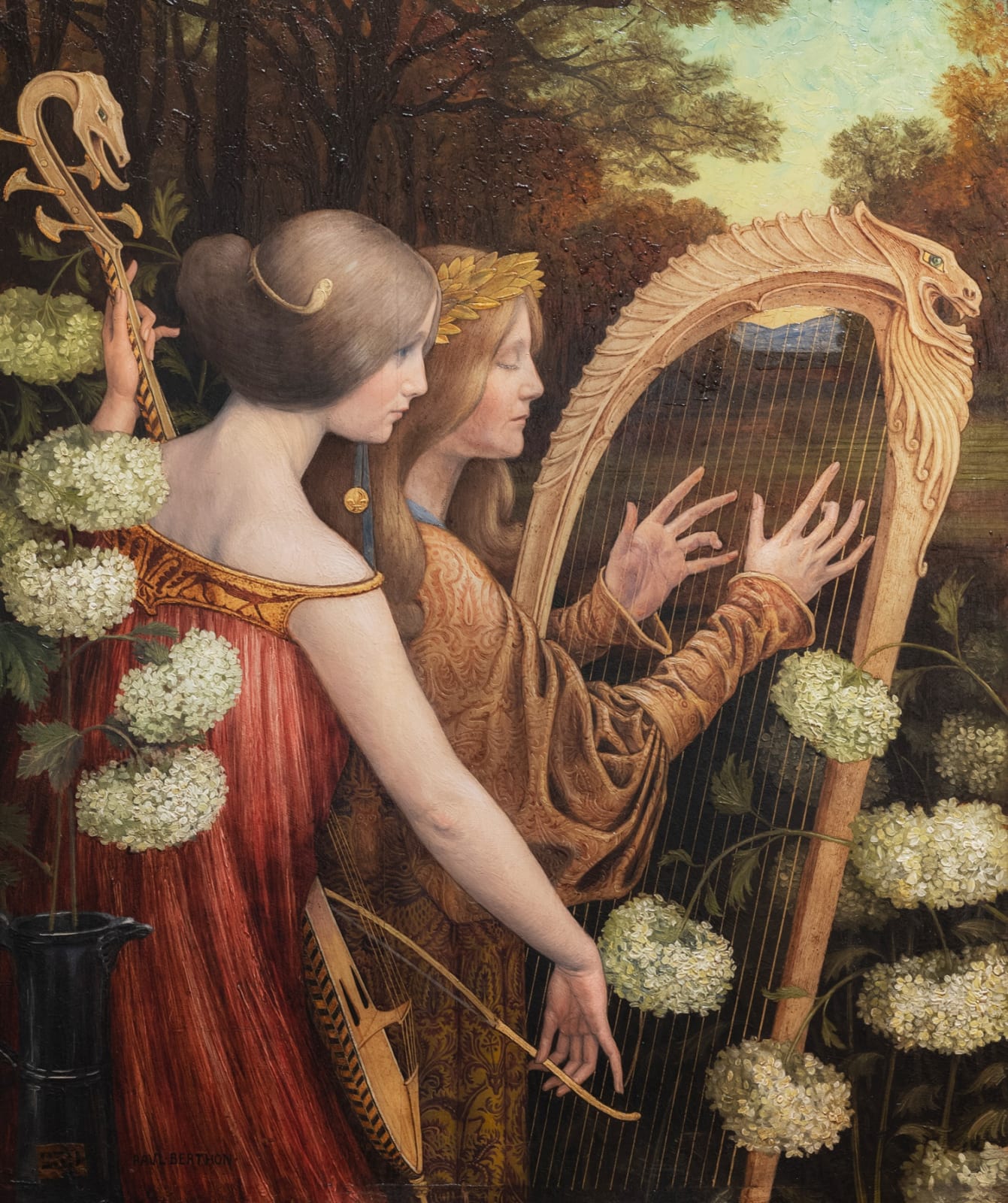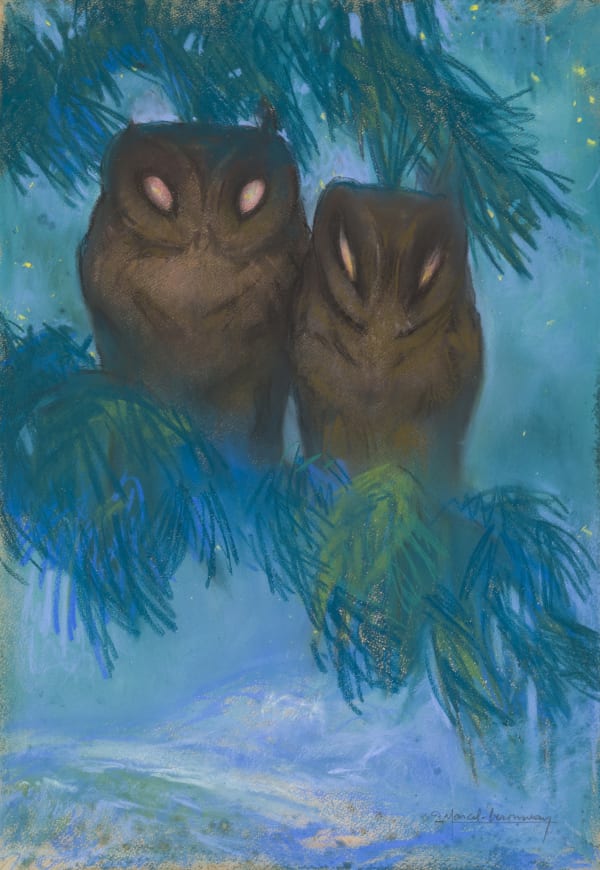-
Artworks

Paul Louis Joseph BERTHON
Les Musiciennes dans un parc, 1905 c.Oil on panel67 x 56 cmSigned lower left: PAUL BERTHON | Tag 259 (Old number. Probably for an unidentified sale)
SOLD
Provenance
Sorrento, Console Michael Senter; Rome, private collection
Exhibitions
1906, Paris, Palais-Salon.
Literature
Henry de Forge, Le Palais-Salon, Le Monde illustré, 6 January 1906, p. 383, reproduit. Fernand Hauser, L’art et la toge. Le Palais-Salon, Le Journal, 15 May 1906, p. 5.
E.G., Au Palais-Salon, L’Intransigeant, 16 May 1906, p. 3.
La Voie ordinaire, Le Palais-Salon, L’Humanité, 16 May 1906, p. 1.
Robert Tenax, L’art et la basoche. Palais-Salon, Journal des artistes, 20 May 1906, p. 5089.
Marcel Mirtil, Palais-Salon, La Grande revue, 1 June 1906, 552-553.Paul Louis Joseph Berthon
(Villefranche-sur-Saône 1872 – Sceaux 1934)Paul Louis Joseph Berthon, better known as Paul Berthon, was born in Villefranche-sur-Saône in 1872. He should not be confused with his namesake, the landscape painter Paul Émile Berthon (1846–1909). Born into a middle-class family, Berthon was the son of a primary school inspector. He began drawing at school and, he moved to Paris at the age of twenty-one, in 1893. As a result, the young man carried out his apprenticeship in the full throes of Symbolism, particularly at the École Normale d’Enseignement du Dessin, also known as the “École Guérin”, founded by the architect Alphonse Guérin. It is likely that Berthon received advice from Luc-Olivier Merson and Puvis de Chavannes, who taught there regularly, but he was clearly more influenced by Eugène Grasset’s courses in decorative art. The influence of this Swiss artist was fundamental in Berthon’s artistic development. In a quite extraordinary way, the young artist began to produce copious numbers of lithographs and other works, which brought him fame from 1895 onwards. For some years, his success was truly remarkable. However, the artist rarely exhibited at the Salon des Artistes Français[1] and at the Salon de la Société Nationale des Beaux-Arts;[2] he was known to the public only as a poster artist and printmaker. In this period of effervescence and renewal of the graphic arts, he was often to be found in new media and Symbolism-related milieus. He produced a large number of lithographs, chromolithographs and woodblock prints, posters, and covers and illustrations for small magazines dedicated to the decorative arts and poetry.Various magazines and publications such as La Plume, L’Hermitage, L’Image, Les Maîtres de l’Affiche, The Poster, and The Chap-Book contributed to the popularization of his images. He also created lithographs for interior decoration, printed by Chaix & Co. His posters for Le Salon des Cent, L’Eldorado, Les Folies Bergère, and some original advertisements, as well as his portraits of Eugène Grasset, André des Gachons or the young Queen Wilhelmine of Holland testify to his commercial success. He also illustrated several anthologies of poetry and even published a book himself: Rêve aux Étoiles (Girard, 1895).His art combines a decorative line close to that of Eugène Grasset, in the spirit of Art Nouveau, with subjects that are more characteristic of Symbolism: timeless women, musical instruments, and flowers. Berthon treated his subjects in a spirit that is both decorative and poetic. His art is easily recognizable, despite its proximity to that of Grasset.However, his public career was as short as it was brilliant: it lasted a mere five or six years; in 1898, the artist married and disappeared from the art scene around 1900. During this short but fruitful period, he never painted on easel. The appearance of Les Musiciennes dans un Parc, an oil on panel, is therefore extremely surprising and informative. This work was exhibited in 1906 at the Palais-Salon; an exhibition organized with the help of the Undersecretary of State for Fine Arts, Étienne Dujardin-Beaumetz, and intended to present works painted by lawyers and magistrates. In fact, we learn that Paul Berthon, who abandoned his career as a poster artist, became a Justice of the Peace in Pontoise and was also a lawyer. A letter from the painter Théophile Steinlen to Socialist MP Alfred-Léon Gérault-Richard reveals that Berthon, “a disciple of [Jules] Bergeret”,[3] had sought the support of the new President of the Council, Georges Clémenceau, to be appointed a judge.[4] Berthon’s career was not without its hiccups. Close to Socialist circles, he finally obtained this status in the city of Pontoise, near Paris. This curious change of heart may have been due to financial problems, a request for stability expressed by his new wife, or the dawning epoch. What is striking, however, is that Berthon, after giving up printmaking, was still obsessed with creation and decided to tackle painting for the first (and only?) time. Like other Symbolist artists, eager to identify with the Italian primitives, Berthon chose a panel instead of canvas as a support. Although he worked in oil at this time, we find the same iconographic repertoire he used in his prints. The two women, one with long hair crowned with laurel, the other with her hair gathered in a headband, both dressed in rocaille outfits with embroidered fabric, are playing instruments: one a richly decorated harp and the other a lute. The decoration consists of flowers nicknamed “snowballs” (Viburnum), found in several of Berthon’s engravings, and a landscape. The overall, poetic, dreamlike atmosphere is reminiscent of many fin de siècle works, but also of the English Pre-Raphaelites.At the time of its exhibition, the work was very well received and was even reproduced in Le Monde Illustré (fig. 1). The critics recalled that this new magistrate had been a renowned artist. The critic of L’Humanité commented: “Before being a judge, Mr. Berthon was an artist: he had his studio near Place Denfert-Rochereau and published curious posters and prints that were highly successful,” while Fernand Hauser noted with amusement: “Mr Paul Berthon, who was exhibiting at the Nationale, now addresses his works to the Palais-Salon, and one wonders whether it is the Justice of the Peace who paints to distract himself or the painter who, to relax, renders justice.”Robert Tenax summarized in his analysis of the Italian masters and a great engraver of the time: “I have reserved a special place for M. Paul Berthon, Justice of the Peace of Pontoise, who, in giving his musicians in the park aesthetic attitudes, recalls Fra Filippo Lippi and Sandro Botticelli: his coloured prints of serene simplicity could be compared to those of the master Henri Rivière.” Finally, the critic of La Grande Revue described this painting as a high-quality work: “The prize goes without a doubt to Mr. Paul Berthon, Justice of the Peace of Pontoise. His painting: Les Musiciennes dans un parc, is a work of a very high standard. [...] These musicians surrounded by flowers have an archaic appearance which idealizes them. They are almost the angels of Lorenzo di Credi or Botticelli. The background of the canvas is remarkably coloured in the Italian manner. Some might argue that this type of painting is a fake, revealing only the skill of the copyist and not the talent of the creator. Literary painting, false painting! That’s what they usually say. The religious spirit that animated the Umbrian and Tuscan painters is missing from our modern artists who, while wishing to imitate them, produce only pastiches. This opinion is certainly true, however literary painting will live on despite the naturalists, because we shall always like to contemplate angels surrounded by flowers, singing or praying in the lovely setting of the Florentine countryside.”Les Musiciennes dans un Parc is the only known oil painting by Paul Berthon. Created after the artist had given up his career as a printmaker, it is a sort of enigmatic and spectacular testament to this creator whose poster production is as well-known as his personality, while his life remains partially shrouded in mystery.Jean-David Jumeau-Lafond[1]In 1896, Berthon exhibited a poster design in the drawings section of the Salon des Artistes Français (n° 3977).
[2] In 1899, Berthon exhibited a decorative project entitled Le Violon at the Société Nationale des Beaux-Arts (No. 1568).
[3] Jules Bergeret (1831–1905) was a socialist personality, Freemason and military leader during the Parisian revolution La Commune of 1871.
[4]Letter sold in Paris, Étude Ader, February 22nd, 2022, no. 42.

Fig. 1 Le Monde illustré, 6 January 1906
Join the mailing list
Subscribe to our newsletter to receive all the news about exhibitions, fairs and new acquisitions!




